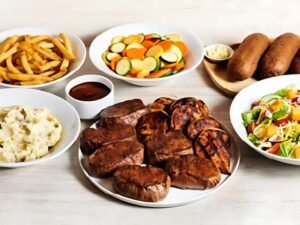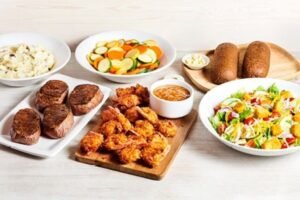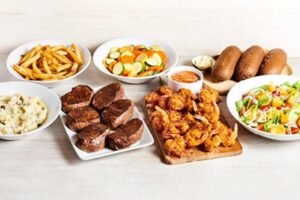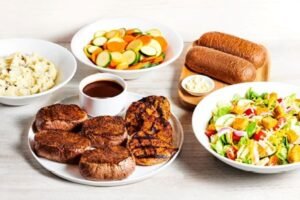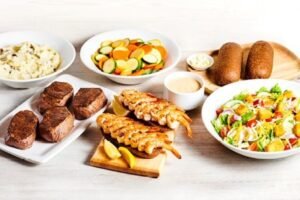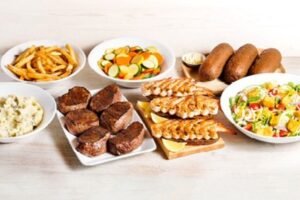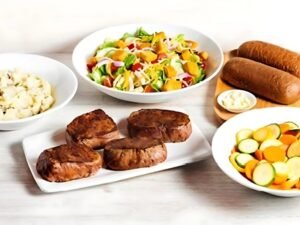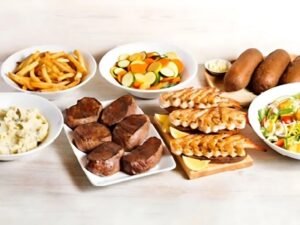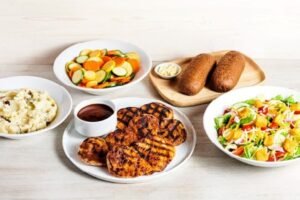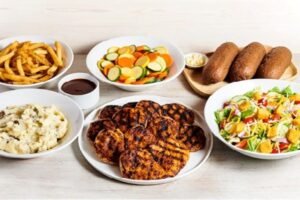When Outback launched Bloomin’ Bundle Meals in 2020, they weren’t just repackaging existing menu items – they were solving a fundamental problem. How do you feed a family of four without spending $100+ on takeout? These bundles crack the code by offering complete meals at price points that make sense for Tuesday night dinners, not just special occasions.
The bundles work because they eliminate decision fatigue while delivering value that feels almost suspicious. Each bundle feeds 4-6 people for the price of two typical entrées, including proteins, sides, salad, and bread. The math seems wrong until you realize Outback’s playing a volume game – better to sell one profitable bundle than lose the family to grocery stores.
The Psychology of Bundle Ordering
Families approach restaurant spending differently than individuals. The mental accounting shifts from “per person cost” to “total damage,” making $60 for four people feel reasonable compared to $15 per person that somehow becomes $80 after drinks and tips. Outback exploits this psychology brilliantly.
The bundle configuration removes the guilt of over-ordering. Everything’s predetermined, eliminating the “should we get an appetizer?” debate. The dessert inclusion prevents the post-meal negotiation about sweets. It’s permission structure for indulgence disguised as responsible family feeding.
Order patterns reveal fascinating behaviors. Single parents order bundles at 3x the rate of two-parent households, suggesting convenience outweighs slight portion excess. Bundles spike on report card days, after soccer tournaments, and during teacher conference weeks – stress eating meets convenience culture.
Kitchen Logistics of Mass Production
Bundle preparation requires completely different kitchen choreography than individual orders. Everything must finish simultaneously since partial delivery defeats the purpose. This synchronization challenge changed how Outback’s kitchens operate during peak bundle hours (5-7 PM).
The Bloomin’ Bundle takes 24 minutes start to finish. The onion drops first, requiring 4 minutes. Steaks hit grills at minute 8, needing 12 minutes for medium. Sides begin at minute 14. Salads assemble at minute 20. Everything converges at minute 24 for packaging. This timeline assumes zero delays – one overcooked steak disrupts everything.
Dedicated bundle stations emerged in high-volume locations. One cook handles all proteins, another manages sides, a third coordinates cold items. This specialization increases accuracy while reducing preparation time by 30%. The investment in additional staff pays off through volume increases.
Packaging Innovation Nobody Notices
Bundle packaging engineering deserves recognition. How do you transport a Bloomin’ Onion without it becoming a soggy mess? The solution involves ventilated containers with raised bottoms, allowing oil drainage while maintaining crispness for 20 minutes. The container costs $2.40 versus $0.30 for standard to-go boxes.
Temperature zones within bundle packaging maintain quality. Hot items occupy insulated sections while salads stay separated in cooling zones. The bread sits atop everything, using rising heat for warmth without direct contact that creates sogginess. This thermal management extends quality window to 45 minutes.
Each bundle arrives in branded bags strong enough to support 15 pounds without tearing. The handles reinforce three times, preventing the tragedy of bottom blow-out in parking lots. These bags cost $0.80 each but prevent disasters that destroy customer relationships.
The Tuesday Night Phenomenon
Bundle sales follow weekly patterns that inform inventory and staffing. Tuesday emerges as peak bundle day – families need easy dinners but resist weekend splurging. Wednesday follows closely, while Monday sees lowest sales as leftovers still exist.
The 5:30 PM rush creates operational stress. Twenty bundle orders in 30 minutes pushes kitchen capacity, especially with regular dine-in service continuing. Some locations implement “Bundle Hours” with streamlined menus and dedicated preparation teams during peak times.
Sports schedules drive micro-patterns. Little League nights see bundle orders placed precisely at 4:45 PM for 5:30 pickup. Sunday football generates appetizer bundle spikes. These predictable patterns enable proactive preparation, reducing wait times.
Portion Math and Leftover Logic
Bundles create intentional leftovers, transforming single-meal purchases into multi-meal value. The Bloomin’ Bundle’s four proteins often become tonight’s dinner and tomorrow’s lunch. Parents appreciate this extended value, justifying the upfront expense.
The leftover quality varies by item. Steaks reheat poorly but work sliced in sandwiches. Ribs maintain quality through proper storage. The Bloomin’ Onion doesn’t survive – it’s eat-now-or-never. Understanding these realities helps families plan consumption.
Portion sizes reflect American abundance. Each bundle technically feeds 4-6, but reality suggests 3-4 hearty appetites or 5-6 moderate eaters. The intentional over-portioning ensures satisfaction while creating value perception through abundance.
Weekend Warrior Bundles
Friday and Saturday bundle orders differ from weekday patterns. Weekend bundles skew toward premium options – Steak & Lobster outsells basic bundles 2:1. Families treat weekends as mini-celebrations, justifying higher-priced options.
Party bundles emerge on weekends. Multiple bundle orders for single addresses indicate gatherings. Some customers order 3-4 different bundles, creating variety for larger groups. These multi-bundle orders average $200+, representing significant revenue from single transactions.
Holiday weekends see explosive bundle growth. Memorial Day, July 4th, and Labor Day generate 5x normal bundle sales. Outback now staffs specifically for holiday bundle preparation, treating these weekends as distinct from normal operations.
The Customization Constraints
Bundles intentionally limit customization to maintain efficiency and pricing. No substitutions, no modifications, no special requests. This rigidity frustrates some customers but enables the value pricing that attracts others.
Common modification requests that get denied:
- Swapping chicken for extra steak
- Replacing sides with additional appetizers
- Splitting bundles between two pickup times
- Creating “half bundles” for smaller families
The no-modification policy speeds preparation while preventing complexity that destroys margins. Customers wanting customization must order à la carte at regular prices. This trade-off maintains bundle economics while preserving options for particular preferences.
